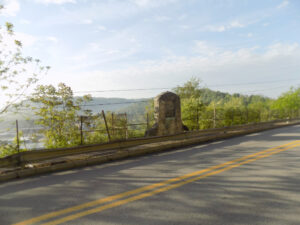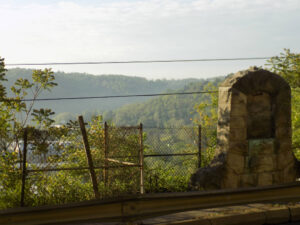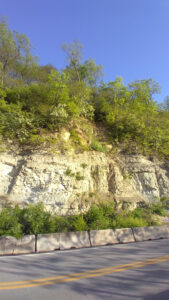With a group of forty cavalrymen, Maj. Samuel McColloch rode to the aid of Fort Henry, near Wheeling, Virginia. It was September 1, 1777, and the fort was under attack by roughly 300 Native Americans: members of the Wyandot, Mingo, Shawnee, and Delaware tribes. Outnumbered, the fort’s commanding officer had called for more militiamen. McColloch answered. Riding heroically into the fray after a brief survey of the landscape, McColloch took control of the column’s rearguard as they approached the fort and the raid, ensuring his men could reach Fort Henry’s gates and safely defend the land.
In doing so, McColloch was cut off from the rest of his men. He was alone with countless Indians descending upon him. Being near the Ohio River and the Appalachian Mountains, the territory protected by Fort Henry was naturally hilly. McColloch ascended nearby Wheeling Hill on his horse and left his unmounted enemies behind, though they eagerly followed him. Unbeknownst to McColloch, this hill had a steep drop into Wheeling Creek. Reaching the summit before his horseless enemies, and having no hope of an unscathed escape, McColloch realized he had only one option: leave the hilltop. But he could not descend the way he rose, as the Native Americans pushed up the hill in pursuit. No, he would have to lead his horse into a great leap down the sharp decline, landing some 300 feet below. This was not just a daring feat: this was life or death. And yet somehow, McColloch, and his horse, escaped unharmed.
The Facts of the Matter
There are many questions surrounding McColloch’s Leap; most prominently, what part of the story is true? Is it all legend? This fabled leap of McColloch’s is not mentioned in any contemporary diaries, newspapers, or official reports. McColloch himself is a bit of a mystery: historians may know a few details about him, but overall those details are not remarkable or even necessarily accurate.[2] The story of McColloch’s Leap, while making a brilliant, daring, and engaging story, appears to be just a story.
There are some facets that can be verified. All records point to a Native American raid on Fort Henry on September 1, 1777, though the number of Indians attacking the fort and the size of the garrison protecting it are up for debate. Most estimates place the garrison’s size at around 300 men, with an unspecified number of women and children within the fort.[3] Colonel David Shepherd commanded the garrison at Fort Henry and was informed of an impending attack on the fort by Detroit-based British rangers, Native Americans, or possibly both.[4] Knowing this, he called for aid from his captains. This is where the information on McColloch, his leap, and the raid on Fort Henry become a little more vague.
Few contemporary records of this siege exist, but there are oral traditions collected by Lyman Draper, who interviewed people with memories of the war in the mid-1800s. One of those interviews was from Dr. Joseph Doddridge. Doddridge, eight at the time of 1777 siege, took shelter in the fort alongside his family. Recalling his memories decades later, he said that the fort called for reinforcements, including militia commanders Williamson, Virgin, Crooks, Miller, Hathaway, Ogle, and Andrew Zane.[5] According to the legend, McColloch was also included (coming from Fort Van Meter), but Doddridge did not mention him.[6] Historians have, however, pointed out that Doddridge’s list of reinforcing commandants is incorrect.[7]
Doddridge also recalled an event similar to McColloch’s Leap. He talked of a commanding officer of the Continental Army who jumped off a cliff (Wheeling Hill) as a means of escape to avoid attacking Native Americans. But Doddridge credited not Samuel McColloch, but Andrew Zane, with the jump.[8] To create more confusion, in an editor’s note contained in the book Frontier Defense on the Upper Ohio, from which Doddridge’s story is drawn, editors Rueben Thwaites and Louise Kellogg write there is no evidence for McColloch’s Leap. Thwaites and Kellogg discredit any notion of the story, regardless of participants, ever occurring during or around the 1777 siege. The editors do speculate that such an event could have happened during another siege in 1781, but cannot definitively prove it. At the same time these editors claim the possibility of the leap occurring in 1781, they posit that McColloch had died prior to the siege (but according to McColloch’s headstone, he died in 1782).[9] Therefore, McColloch could not have participated in the leap, and the editors’ timeline seems to be a bit off. In the same short note, the editors emphasize the folkloric aspects of the tale, but do not discredit it entirely.[10]

Adding another layer of complexity, and possibly reinforcing Doddridge’s claim, the wife of Joseph Stagg (née Mills, whose first name appears lost to history), recalled an incident when Zane, not McColloch, jumped from a great height to escape an Indian attack. This height was only estimated to be about 70 feet, a far cry from the fabled 300 feet McColloch allegedly survived.[11] At the same time, writers have called into question the reliability of Thwaites and Kellogg’s editorial work, as well as that of other historians.[12] Thankfully, most researchers on the matter agree that Doddridge’s recollections, compiled by Draper, are likely the most dependable sources of information.
As Doddridge is the only source with a tangible tie to the siege and the only person who could have witnessed the events surrounding the fabled jump McColloch made, it makes sense he would be the one of the best resources. That being said, there is limited credibility to his story. Doddridge was only eight years old during the siege in 1777, and twelve at the time of the 1781 siege. Though his story is supported by Mrs. Stagg, Doddridge wrote his memories down decades later, which created an incomplete manuscript that cannot be located currently nor can be verified without the aid of other sources.[13] Communications with reference librarians, local historians and researchers proved fruitless, unfortunately. In short, little, if any, of the story of McColloch’s Leap can be verified.
No two sources totally agree on what occurred during the Siege of Fort Henry in 1777, so each source must be closely analyzed and thoroughly compared to the others. Again, while there is little definitive proof of McColloch’s Leap, this narrative relies on recollection years or decades after the fact and on second-hand information. At least two sources agree that a jump of some sort happened, but there are disagreements on height of the jump and the participant. At worst, this is an entirely fictional tale. At best, the miraculousness of McColloch’s Leap continues to decrease.
The Legend Evolves
Making this more interesting is the level of reverence that the story commands in the history of Wheeling, Virginia (now Wheeling, West Virginia). As seen from various sources dated across the 1800s, this event played a significant role in the culture of the Ohio River city. Today, there are businesses (like the Leap Café) and roads (McColloch Street) named for it. Samuel McColloch is affectionately referred to as “Major Sam” by many locals.

In 1917, 140 years after McColloch’s fabled leap, the most noticeable memorial to him was erected. The newly-chartered chapter of the Daughters of the American Revolution (DAR) in Wheeling gathered funds to build an eight-foot-tall stone monument to McColloch, now known as the “McColloch’s Leap Monument.” It included a plaque with an inscription:
Major Samuel McColloch
daring scout, gallant soldier
while attempting the relief of
Fort Henry at Wheeling
September, 1777
escaped an overwhelming body of Indians
by forcing his horse over this precipice[14]

While it is certainly a positive thing to honor the soldiers of the American Revolution, one must ask how the newly formed DAR chapter sourced their information for accuracy? Attempts to contact the (allegedly) still active chapter, along with the state and national organizations, have failed. As such, historians and curious individuals may never know how the Wheeling chapter came to their decision to erect this monument.

What is known is that this chapter, from their inception in February 1916, wanted to make a name for themselves. In the October 1917 issue of the Daughters of the American Revolution Magazine readers can see the chapter’s desire to stand out among others. As the chapter was created during World War I, its members elected to send monetary aid to the Belgian Relief Committee, for the sum of $57, no small sum in that era for only twenty-six initial members.[15] The chapter “also contributed $15 toward the memorial tablet on the dreadnoughtWest Virginia.”[16] Within the first year of existence, the chapter had already made a name for itself.
Monetary donations were not the only impact the chapter had hoped to make. In their inaugural year, the chapter had “undertaken, however, for its specific work the marking of the Old Trails Road where it crosses West Virginia. . . . The Chapter has planned to place markers similar to those used by the Society in other parts of the country.”[17] The Old Trails Road, now more commonly known as the National Road, runs through Wheeling, and is where the McColloch’s Leap Monument is located.
In erecting the monument to Major Sam, the chapter more effectively put the man and his fabled leap on the map. However, as evidenced by other activities of DAR chapters, like the story of Sybil Ludington, just because a chapter or two makes an effort to recognize an incident in American history, does not make it true.[18] Indeed, ever since the installation of the monument, and seemingly before as well, there has been increasing scrutiny leveled at the story of McColloch’s Leap. The bicentennial committee organized to commemorate the history of Fort Henry mentions McColloch but points out that there is only the most tenuous of evidence to support the story of his leap.[19] The writers of the Fort Henry Bicentennial Committee’s findings, Richard Klein and Alan Cooper, also wrote a three-part biography of McColloch for the Wheeling Intelligencer in April 1977, and even the first few paragraphs are chock-full of timeline errors.[20] It appears whatever sources were used to support the erection of the McColloch’s Leap Monument, alongside the legend of the man himself, are lost.
While the story of McColloch’s Leap cannot be definitively proven, it is unfortunate that more information cannot be gleaned from the historical records to either prove or disprove it. As the evidence sits, it seems plausible that an event such as McColloch’s Leap occurred, but there are outstanding questions surrounding the event. Paula Hunt, a historian who researched the Sybil Ludington claims, wrote that “the story of the lone, teenage girl riding for freedom, it seems, is simply too good not to be believed.”[21] Perhaps this daring escape of the leader of heroic reinforcements is a similar story.
[1]J. H. Newton, G. G. Nichols, and A. G. Sprankle, History of the Pan-Handle; Being Historical Collections of Ohio, Brooke, Marshall, and Hancock, West Virginia (Wheeling, WV: J. A. Caldwell, 1879), 134.
[2]Ibid., 134-135. The compilers of this collection write they regret that “more of the stirring incidents of this man’s life have not been collected and preserved. We have heard of many daring feats of personal prowess, but they come to us in such a mixed and unsatisfactory form, as to render their publication, at this time, unsafe.” However, the authors themselves provide little in the way of source material, which may, alongside the other “incidents,” render this matter moot, as there are no primary sources dealing with this event.
[3]Richard Klein and Alan Cooper, “The Fort Henry Story by Klein and Cooper,” Ohio County Public Library, www.ohiocountylibrary.org/history/the-fort-henry-story-by-klein-and-cooper/3699. Originally published by the Fort Henry Bicentennial Committee, 1982.
[4]Rueben Gold Thwaites and Louise Phelps Kellogg, eds., Frontier Defense on the Upper Ohio, 1777-1778 (Madison, WI: Wisconsin Historical Society, 1912), 55. This text contains a large selection of primary source documents, mostly letters, and interviews, usually from family.
[5]“Reminiscences of Dr. Joseph Doddridge,” in Frontier Defense on the Upper Ohio, 55-56.
[6]Klein and Cooper, “The Fort Henry Story by Klein and Cooper”; Joe Roxby, “A Tale of Three Sams,” in Legendary Locals of Wheeling, eds. Seán Duffy and Brent Carney (Mount Pleasant, South Carolina: Arcadia Publishing, 2013), 12.
[7]“Reminiscences of Dr. Joseph Doddridge,” in Frontier Defense on the Upper Ohio, 56.
[9]“Maj Samuel McColloch,” Find A Grave, www.findagrave.com/memorial/111820245/samuel-mccolloch. McColloch’s death allegedly came during an Indian ambush, when he was with his brother, John McColloch. Having initially fled the scene, John returned the next day and found Samuel’s corpse defiled: the Native Americans had removed Samuel’s heart, presumably to eat it. According to Richard Klein and Alan Cooper, writing for the Wheeling Intelligencer in 1977, some Native American tribes would eat portions of valorous enemies, in hopes of increasing their own courage. For more information, refer to the inscription on McColloch’s tombstone and also the third part of Klein and Cooper’s biography of Samuel McColloch, “History Is Very Skimpy,” www.ohiocountylibrary.org/research/wheeling-history/4298#part3.
[10]Frontier Defense on the Upper Ohio, 68.
[11]“Recollections of Mrs. Joseph Stagg,” in Frontier Defense on the Upper Ohio, 63.
[12]Klein and Cooper, “The Fort Henry Story by Klein and Cooper.”
[13]“Reminiscences of Dr. Joseph Doddridge,” in Frontier Defense on the Upper Ohio, 55-56.
[14]J.J. Pratts, “McColloch’s Leap,” Historical Marker Database, www.hmdb.org/m.asp?m=513.
[15](Mrs. S. P.) Cornelia Lomax Christian, “Work of the Chapters,” Daughters of the American Revolution Magazine, Vol. 51, No. 4 (October 1917), 249-250.
[18]Paula D. Hunt, “Sybil Ludington, the Female Paul Revere: The Making of a Revolutionary War Heroine,” The New England Quarterly, vol. 88, no. 2 (June 2015): 189.
[19]Klein and Cooper, “The Fort Henry Story by Klein and Cooper.”
[20]Wheeling Intelligencer, April 2, April 9 and April 16, 1977.







Recent Articles
Supplying the Means: The Role of Robert Morris in the Yorktown Campaign
Revolution Road! JAR and Trucking Radio Legend Dave Nemo
Those Deceitful Sages: Pope Pius VI, Rome, and the American Revolution
Recent Comments
"Texas and the American..."
Mr. Villarreal I would like to talk to you about Tejanos who...
"Trojan Horse on the..."
Thank you Eric! I should say that I have enjoyed your work...
"Trojan Horse on the..."
Great article. Love those events that mattered mightily to participants but often...